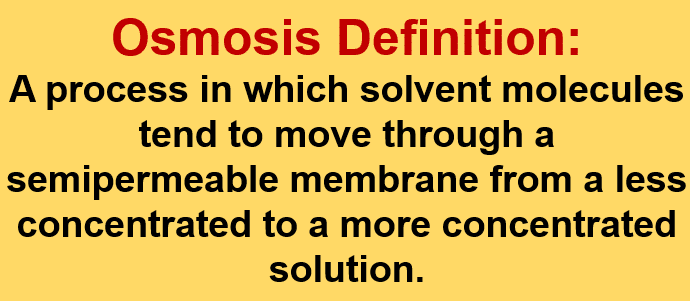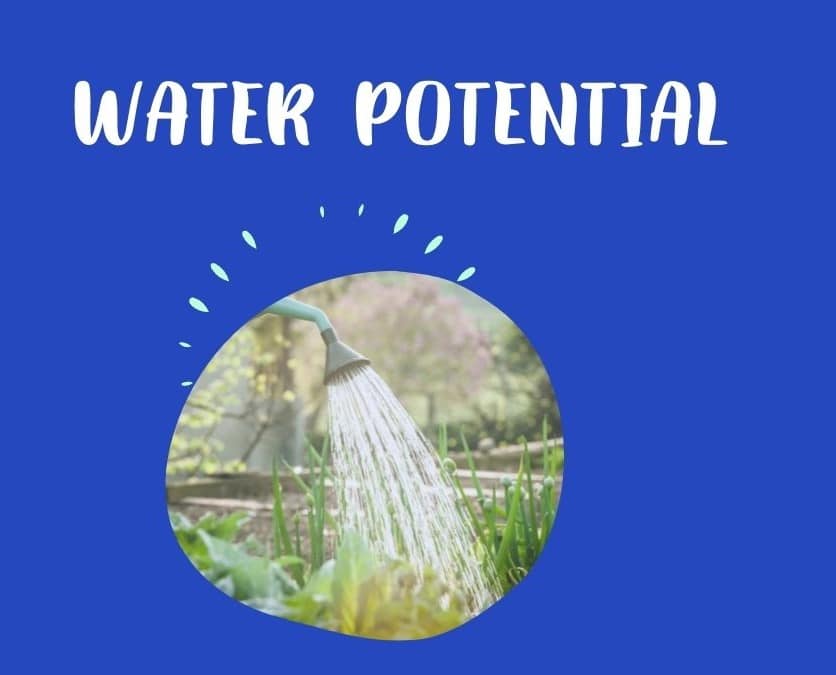Osmosis definition: A process in which solvent molecules tend to move through a semipermeable membrane from a less concentrated solution to a more concentrated solution.

Table of Contents
Osmosis Definitions
- The passage of a solvent (such as water) through a semipermeable membrane (such as the membrane of a live cell) into a solution with a higher solute concentration, tends to equalize the solute concentrations on both sides of the membrane.
- Osmosis is a process in which solvent molecules transfer from a low-concentration solution to a high-concentration solution over a semi-permeable membrane.
- In biology, osmosis is the passage of water molecules through a cell’s partly permeable membrane from a solution with a high concentration of water molecules to a solution with a lower concentration of water molecules.
Daily Life Examples of Osmosis
| Applications | Explanation |
| Plant absorption | Plants absorb water and nutrients from the soil through osmosis. |
| Kidney function | Kidneys filter waste products from the blood through osmosis. |
| Food preservation | Preservation of foods such as meat, fish, and vegetables by soaking them in a concentrated salt or sugar solution. |
| Dialysis | A medical treatment that uses osmosis to remove waste products from the blood of patients with kidney failure. |
| Dehydration | When the body loses water through osmosis, resulting in an imbalance in the concentration of salt or sugar in the blood. |
| Reverse osmosis | A process used to purify water by forcing it through a semipermeable membrane under pressure. |
| Cell membranes | Cell membranes rely on osmosis to maintain their structure and function by allowing water and dissolved substances to pass into and out of the cell. |
What are Semipermeable Membranes?
Semipermeable membranes are biological or synthetic polymeric membranes that allow specific molecules or ions to pass through them via osmosis or other specialized processes such as assisted diffusion, passive transport, or active transport.
What are Solvents?
A solvent is a substance in which a solute dissolves and creates a solution.
Solvents are usually liquids, although they can also be solids, gases, or supercritical fluids.
The term ‘solvent‘ refers to a large number of
chemical substances which are used to dissolve
or dilute other substances or materials.
Organic liquids are the most common solvents. Many solvents are also flammable.
They are used as chemical intermediates, fuels, and other applications.
The substances that form a solution cannot be separated even with the use of a filter.
What are Solutes?
A solute is a material in the solution that is present in the smallest amount.
A solvent is a substance that makes up the majority of the solution.
Salt in water is a common example of a solute. The solute, salt, dissolves in the solvent, water, to generate a saline solution. Water vapor, on the other hand, is classified as a solute in the air since nitrogen and oxygen are present in considerably higher concentrations.
Important Points
| Osmosis | Explanation |
| Definition | Osmosis is the process by which solvent molecules pass through a semipermeable membrane from a less concentrated solution to a more concentrated solution. |
| Driving force | The driving force behind osmosis is the concentration gradient, which is the difference in solute concentration between the two solutions separated by the semipermeable membrane. |
| Direction of flow | Water molecules move from the solution with lower solute concentration to the solution with higher solute concentration until equilibrium is reached. |
| Importance | Osmosis is important in many biological processes, including plant absorption of water and nutrients, kidney function, and maintenance of cell structure and function. It is also used in food preservation, dialysis, and water purification. |
| Factors affecting osmosis | The rate of osmosis is affected by several factors, including the concentration gradient, temperature, pressure, and the characteristics of the semipermeable membrane. |
Related Links
Diffusion Coefficient
Concentration Gradient Definition| Easy Examples
Room Temperature| Comfortable Temperature
How Much is a Liter of Water?
Laminar Flow| Physics
Frequently Asked Questions (FAQs)
1. What is Diffusion?
Diffusion is defined as the net passive movement of molecules or particles from higher to lower concentration regions. A concentration gradient is required for diffusion to occur.
2. What is osmotic pressure?
The pressure that must be given to a solution to stop the flow of solvent molecules across a semipermeable membrane is known as osmotic pressure (osmosis).
3. What are the uses of osmosis?
Osmosis serves a variety of life-sustaining tasks, including assisting plants in receiving water, preserving fruit and meat, and even being employed in renal dialysis. Furthermore, osmosis may be used to remove salt and other contaminants from water by reversing the process.
Multiple Choice Questions
- What is osmosis?
a. The movement of solute molecules from a more concentrated solution to a less concentrated solution.
b. The movement of solvent molecules from a more concentrated solution to a less concentrated solution.
c. The movement of solvent molecules from a less concentrated solution to a more concentrated solution.
d. The movement of solute molecules from a less concentrated solution to a more concentrated solution.
Answer: c. The movement of solvent molecules from a less concentrated solution to a more concentrated solution.
- What is the driving force behind osmosis?
a. The concentration of solute molecules.
b. The concentration of solvent molecules.
c. The temperature of the solutions.
d. The pressure of the solutions.
Answer: a. The concentration of solute molecules.
- In which direction do water molecules move in osmosis?
a. From the solution with higher solute concentration to the solution with lower solute concentration.
b. From the solution with lower solvent concentration to the solution with higher solvent concentration.
c. From the solution with higher solvent concentration to the solution with lower solvent concentration.
d. From the solution with lower solute concentration to the solution with higher solute concentration.
Answer: c. From the solution with higher solvent concentration to the solution with lower solvent concentration.
- Which of the following is an example of osmosis in daily life?
a. Water flowing downhill.
b. Plants absorbing water and nutrients from the soil.
c. A ball rolling down a hill.
d. An ice cube melting in a glass of water.
Answer: b. Plants absorbing water and nutrients from the soil.
- What factors affect the rate of osmosis?
a. The concentration gradient, temperature, pressure, and characteristics of the semipermeable membrane.
b. The color of the solutions, the pH of the solutions, and the time of day.
c. The shape of the container, the volume of the solutions, and the type of solute.
d. The age of the solutions, the amount of light, and the atmospheric pressure.
Answer: a. The concentration gradient, temperature, pressure, and characteristics of the semipermeable membrane.
Practice Exam Questions
- What is osmosis and how does it work?
Osmosis is the movement of solvent molecules from a region of higher concentration to a region of lower concentration across a semipermeable membrane. It works by the solvent molecules diffusing through the membrane until the concentrations on both sides of the membrane become equal. - What is a semipermeable membrane?
A semipermeable membrane is a membrane that allows certain molecules to pass through it while preventing others from passing through. In osmosis, the membrane allows solvent molecules to pass through but not solute molecules. - What is the driving force behind osmosis?
The driving force behind osmosis is the concentration gradient, which is the difference in solute concentration between the two solutions separated by the semipermeable membrane. - How does osmosis affect living cells?
Osmosis is important in maintaining the proper balance of water and solutes inside and outside of living cells. If too much water enters or leaves a cell through osmosis, it can cause the cell to swell or shrink, which can be harmful or even lethal. - What factors affect the rate of osmosis?
The rate of osmosis is affected by several factors, including the concentration gradient, temperature, pressure, and the characteristics of the semipermeable membrane. - What are some real-world applications of osmosis?
Osmosis is used in a variety of real-world applications, such as water purification, food preservation, and medical treatments like dialysis. It is also important in plant absorption of water and nutrients and kidney function.
More Links
- BCl3 Lewis Structure in four simple steps - November 1, 2023
- PH3 Lewis Structure in four simple steps - October 8, 2023
- PF3 Lewis structure in four simple steps - September 24, 2023



